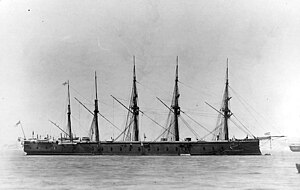HMS Northumberland (1866)
 Northumberland in her original 5-masted configuration
| |
| History | |
|---|---|
| Name | HMS Northumberland |
| Namesake | Northumberland |
| Ordered | 2 September 1861 |
| Builder | Millwall Iron Works, Millwall, London |
| Cost | £444,256 |
| Laid down | 10 October 1861 |
| Launched | 17 April 1866 |
| Completed | 8 October 1868 |
| Commissioned | October 1868 |
| Decommissioned | 1898 |
| Out of service | Hulked , 1909 |
| Renamed |
|
| Reclassified | Training ship, 1898 |
| Stricken | 1927 |
| Fate |
|
| General characteristics (as completed) | |
| Class and type | armoured frigate |
| Displacement | 10,584 long tons (10,754 t) |
| Length | 400 ft 4 in (122.0 m) p/p |
| Beam | 59 ft 5 in (18.1 m) |
| Draught | 27 ft 9 in (8.5 m) |
| Installed power |
|
| Propulsion | 1 shaft, 1 Trunk steam engine |
| Sail plan | 5-masted |
| Speed | 14 knots (26 km/h; 16 mph) |
| Range | 2,825 nmi (5,232 km; 3,251 mi) at 10 knots (19 km/h; 12 mph) |
| Complement | 800 |
| Armament |
|
| Armour | |
HMS Northumberland was the last of the three
Design and description
The Minotaur-class armoured frigates
Northumberland was 400 feet 4 inches (122.0 m)
Propulsion

Northumberland had a two-cylinder
Originally designed with three masts, Northumberland was fitted with five masts until her 1875–79 refit when two were removed and she was re-rigged as a barque.[7] Northumberland only made 7 knots (13 km/h; 8.1 mph) under sail,[8] mainly because the ship's propeller could only be disconnected and not hoisted up into the stern of the ship to reduce drag, the worst speed of any ironclad of her era.[9] Admiral George A. Ballard described the Minotaur-class ships as "the dullest performers under canvas of the whole masted fleet of their day, and no ships ever carried so much dress to so little purpose."[10]
Armament

Unlike her half-sisters, Northumberland was armed with a mix of seven-inch (178 mm), eight-inch (203 mm), and nine-inch (229 mm)
The nine-inch gun was credited with the ability to penetrate 11.3 inches (287 mm) of
Northumberland was partially rearmed in 1875 with an armament of 7 nine-inch guns, 4 on the main deck, 2 forward chase guns and 1 rear chase gun. Two eight-inch guns replaced the seven-inchers on the main deck at the stern; the other 18 eight-inch guns remained where they were. In 1886 two six inches (152 mm) breech-loading guns replaced two eight-inch guns.
Armour
Unlike her half-sisters, the entire side of Northumberland's
Construction and service
Northumberland, named after the

The ship's first posting was to the Channel Squadron, where she remained until 1873. Her first captain, Roderick Dew, had all of her

She was anchored at Funchal, Madeira, on Christmas Day 1872, when a storm parted her anchor chain and the ship drifted onto the ram bow of the ironclad Hercules. Northumberland was seriously damaged below the waterline, with one compartment flooded, though she was able to steam to Malta for repairs.[17]
While her half-sister
Northumberland was assigned to the 1st Reserve Squadron at the
Relics
Two large 1870s half-scale models of the ship are at the Museum of London Docklands.[20]
Notes
- ^ Ironclad is the all-encompassing term for armoured warships of this period. Armoured frigates were basically designed for the same role as traditional wooden frigates, but this later changed as the size and expense of these ships forced them to be used in the line of battle.
Footnotes
- ^ Parkes, pp. 60–61
- ^ Ballard, p. 241
- ^ Parkes, pp. 60, 67
- ^ a b Parkes, p. 64
- ^ Ballard, pp. 28, 246–47
- ^ Silverstone, p. 157
- ^ Parkes, p. 66
- ^ Parkes, p. 63
- ^ Ballard, p. 38
- ^ Ballard, p. 26
- ^ a b Parkes, p. 65
- ^ Chesneau & Kolesnik, p. 6
- ^ Chesneau & Kolesnik, p. 10
- ^ Parkes, pp. 64–65
- ^ Silverstone, p. 254
- ^ Ballard, pp. 39, 240; Parkes, pp. 64–65
- ^ a b Ballard, p. 41
- ^ Ballard, pp. 41–42
- ^ Ballard, p. 42; Parkes, p. 67
- ^ "Port and river collection". Museum of London Docklands. Retrieved 17 June 2013.
References
- ISBN 0-87021-924-3.)
{{cite book}}: CS1 maint: multiple names: authors list (link - ISBN 1-84067-529-2.
- Chesneau, Roger & Kolesnik, Eugene M., eds. (1979). Conway's All the World's Fighting Ships 1860–1905. Greenwich, UK: Conway Maritime Press. ISBN 0-8317-0302-4.
- Parkes, Oscar (1990). British Battleships (reprint of the 1957 ed.). Annapolis, Maryland: Naval Institute Press. ISBN 1-55750-075-4.
- Silverstone, Paul H. (1984). Directory of the World's Capital Ships. New York: Hippocrene Books. ISBN 0-88254-979-0.
